The Bizarre History Of Ellis Island
The Bizarre History Of Ellis Island

There are a handful of locations around the US that hold a special place in history, and Ellis Island is one of those: according to The New York Times, it’s estimated that 40 percent of 21st-century Americans can trace their family back to their US origins and find someone who passed through the immigration center on Ellis Island.
The numbers are shocking: between 1892 and 1954, more than 12 million people crossed the island on their way to starting a new life. (If your family came to the US just a little bit earlier, between 1855 and 1890, chances are pretty good they were one of the estimated 8 million people who passed through Ellis Island’s little-known predecessor, Castle Garden. Can’t find proof? That’s not surprising: a massive fire in 1897 destroyed more than 40 years of records.)
It’s difficult to imagine what walking through Ellis Island must have been like — a chaotic hustle and bustle of people feeling equal parts fear and hope, the chatter in all different languages, the squeal of excited kids. But it didn’t always look like that: Ellis Island has actually changed a lot over the course of its history, and only a small part of that was spent as the gateway to the US.
Things were very different before the Europeans came

Ellis Island’s immigration center opened in 1892, but the National Park Service says both Ellis Island and the neighboring Liberty Island were an important part of the day-to-day lives of the nearby Algonquian tribes starting in at least 994 AD.
Just a quick glance at New York’s and New Jersey’s waterways now and it’s clear things are in a dire state in the 21st century — according to Riverkeeper, they’re filled with cigarette butts, foam, and more plastics than a person can realistically imagine being in one place. That makes it hard to picture today, but for centuries, the waters around the two islands were filled with wildlife. Oysters, crabs, clams, fish . there were plenty of small animals, too, and the islands were such an important food source for so long that when the Dutch discovered the harbor, they named Ellis and Liberty islands the “Oyster Islands.”
At first, the European settlers and the Native Americans shared the land and traded — often, it was a trade of furs and pelts (and the right to hunt) for things like tools, weapons, and cast iron. But after only a few decades of contact, conflict and disease pushed the tribes out of the area, and in 1674, “Little Oyster Island” was given to one Captain William Dyre.
For years it was a place of executions

Ellis Island has changed hands a lot over the course of its history, and according to the History of New York City, one of the most. colorful names it had was undoubtedly Gibbet Island. It picked up that grisly moniker at some point in the 18th century, and the reason for it is exactly what it sounds like. Numerous executions took place on the island, and most were people found guilty of piracy. Then, there was also the sordid little addendum that the bodies were left hanging as a warning for others.
Many of the names have — perhaps unsurprisingly — been lost to history, but there’s a few remembered by the books. According to the National Park Service, Charles Gibbs and Thomas J. Wansley met their end with a hangman’s noose on April 22, 1831. Their crime? Mutiny, sparked by the desire to seize a ship full of silver. The captain and the first mate were killed, so then the pirates were, too.
It’s also worth a footnote that Liberty Island was used for hanging pirates, too; in 1860, The New York Times reported on the long list of hangings that happened on the island then called Bedloe’s. Among them were Cornelius Wilhelms — for attempting to seize a ship and killing several female passengers in the process — and Elias Hicks, for “similar crimes.”
Ellis Island is actually sort of in New Jersey

According to The New York Times, there’s been a lot of debate over whether Ellis Island belongs to New York or New Jersey. It is, after all, just 1,300 feet from Jersey and more than a mile from New York City, specifically Manhattan, but distance doesn’t always matter.
The whole thing started back in 1664, with a grant that described New Jersey as “bound on the east part by the main sea, and part by Hudson’s river.” According to New Jersey, that meant they were entitled to everything up to the halfway point in the river, while New York said that no, their claim ended on the river’s shore. It seems like a minor debate, but it left Ellis and Liberty Island up for grabs. That continued until 1834, when the states decided on boundaries and New York got the islands. But it got more complicated. The waters around the islands were technically New Jersey’s, but when New York started digging subways and dumping fill into the waters to enlarge the islands, well, who owns that bit now? The federal government! Isn’t red tape fun?
Then, in 1986, a National Park Service employee lost part of his leg, and no one could decide who was responsible. In the end, New York kept Liberty Island and New Jersey kept Ellis Island . except for 4.68 acres, which still belong to New York.
Getting in and out of Ellis Island could be very easy.

Anyone who’s stood in line for an international flight knows what a hassle it is. Surely, immigrants coming to Ellis Island for the first time had it harder. right?
Fun fact: according to The Statue of Liberty — Ellis Island Foundation, first and second class passengers didn’t have to go through the queues on the island at all. Their questions were answered on board the ship, and as they had already proved themselves wealthy enough to afford the expensive tickets, they were shown into the country. The thinking was that these passengers were unlikely to become a burden to society, but for those traveling in steerage, that wasn’t as clear-cut.
Those were the passengers that waited in long lines, answered various questions, and underwent a medical exam. Ellis Island employees would be working off something that was basically a cargo manifest for passengers, and before the ship was even allowed to dock, it was quarantined so doctors could look for signs of highly contagious diseases like smallpox. Passengers were given tags that corresponded with the manifest and surprisingly, History says that for about 80 percent of people, they were through Ellis Island and into the US in just a matter of a few hours.
. or, getting out of Ellis Island could be very hard
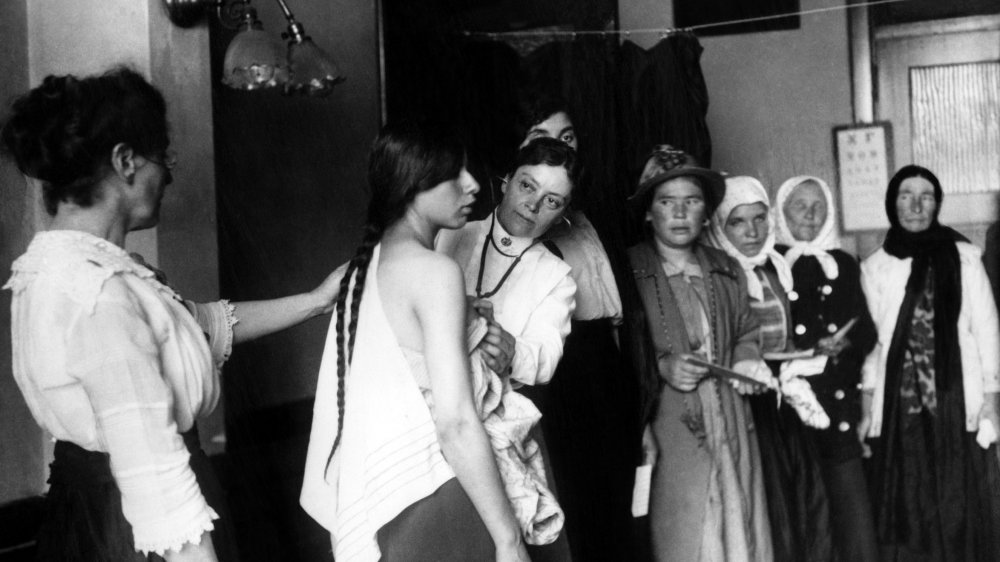
If, as History says, 80 percent of immigrants had an easy time getting through Ellis Island, what about the other 20 percent? It varied. According to PBS, most of the people who were detained or denied entry were those thought to run the risk of becoming a burden on society. That makes sense, but the list of these people looks pretty strange. Stowaways and criminals weren’t allowed through, but neither were Bolsheviks, and anyone deemed to be “immoral.” There’s a lot of grey there, and at the top of that list were children and unescorted women — especially if they were pregnant.
Some were were turned away for medical reasons or held in Ellis Island’s hospital, but this was the case for less than 1 percent of immigrants. Still, that’s around 80,000 people, and the AMA Journal of Ethics says there was a variety of reasons people could be stopped. But some were given medical care, and by 1907, it had been established that treating those who needed to be hospitalized was simply the right thing to do.
Other times, people were turned away because it was decided they had an inability to work and support themselves. The reasons for this included old age, hernias, poor vision, deformities of the arms, legs, or spine, and even varicose veins. Still, the growing country needed laborers, and most were pushed through.
Pass or fail: the feature profile test

Ellis Island officers were particularly concerned with the mental acuity of immigrants, and according to the AMA Journal of Ethics, anyone who didn’t quite measure up in the eyes of officers was pulled aside for a mental examination. They were often gives puzzles to complete or a group of cubes, and asked to perform certain tasks. This was harder than it sounds — remember, these people have just spent a long time in a very uncomfortable, crowded ship in conditions that were unsanitary at best. Many were exhausted, hungry, and scared, and a lot of them didn’t speak English.
The Smithsonian has one of the puzzles they were given, and honestly? Even English-speakers who know the wooden blocks fit together somehow might be hard-pressed to figure out what it’s supposed to be. It’s called the Feature Profile Test, and in theory, it’s supposed to confirm a person knows where facial features belong on a face. It was developed by Howard A. Knox, and it was actually a major advancement. Before, people were tested with more traditional IQ tests — and given the language barrier and culture shock most were working with, it really wasn’t effective. Still, that simple wood puzzle almost perfectly illustrates why Ellis Island received its immigration-era nickname: the Island of Tears.
The first immigrants through Ellis Island were children traveling alone
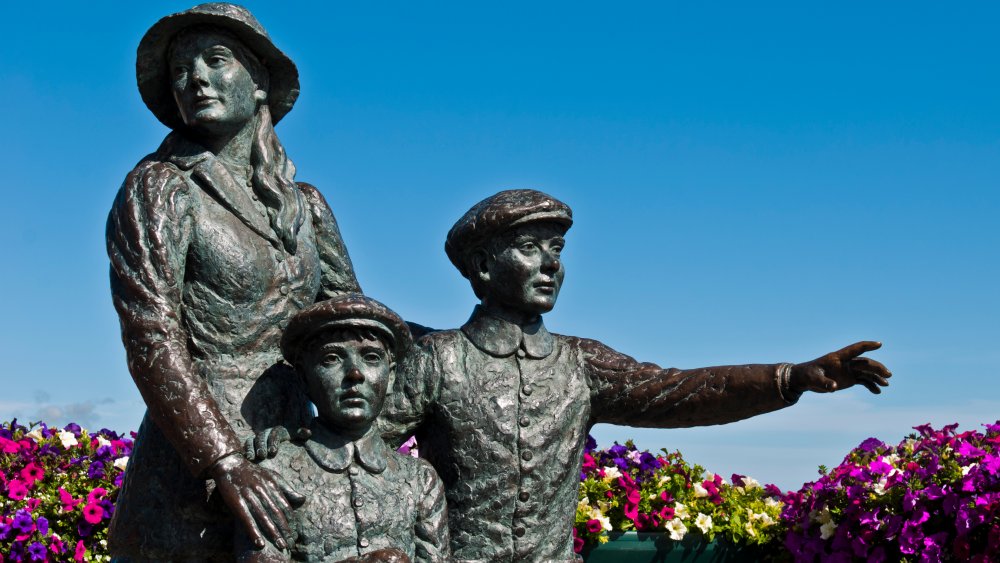
While you might expect Ellis Island’s immigrants to be made up of young adults heading out for adventure or families packing up and moving all at the same time, there were actually millions of unaccompanied minors who made the trip on their own.
The very first person in line to go through Ellis Island on its opening day was 15-year-old Annie Moore, and she made the trip from Ireland with her two little brothers in tow, and no adults. Her parents had made the undoubtedly difficult decision to go on ahead; they had made the trip three years prior, and were waiting to greet the children when they got off the island.
That wasn’t the case with everyone, though. By 1907, unaccompanied minors had become such a common occurrence that legislation was put in place to deal with them. It’s not as dire as it sounds, though, and Mother Jones says there was a whole network set up to help the children — who were often orphans. After being detained on the island, a hearing would be held to decide what to do with them. But there’s good news: churches, synagogues, missionaries, well-to-do private citizens, and immigrant aid societies were often on hand at the hearings, and would offer to be the child’s guardian. In the meantime, children would be under the stewardship of matrons on the island.
No names were changed on Ellis Island

It’s a common story — if your own family doesn’t tell it, there’s a good chance you know someone who does. Names, popular belief goes, were “Americanized” at Ellis Island. They were misheard, misunderstood, or just made easier for the people already living in the US to understand. Only it didn’t happen. At all.
Like. never, ever. According to the New York Public Library, there’s a very simple reason we know this: inspectors at Ellis Island never wrote down or copied names. They only compared names to those listed on ships’ manifests, and the only thing they were looking for was to make sure everything matched. So, what happened? Most of the immigrants that did have their names changed did it themselves. Some did it to sound more American, and some figured that since they were starting a new life, they might as well start completely fresh.
There was one exception, and it’s pretty awesome. A passenger named Frank Woodhull was pulled aside for suspected tuberculosis, and found to be a person actually named Mary Johnson. After spending 15 years living as a man in order to broaden the array of opportunities before him, Woodhull/Johnson found himself in front of an Ellis Island hearing. The verdict? He was “a desirable immigrant [who] should be allowed to win her livelihood as she saw fit.” And his name was officially changed.
Families didn’t always know what happened on Ellis Island

Families weren’t judged as families, they were judged on an individual basis. And that, says the AMA Journal of Ethics, means they were often separated. Husbands and wives, parents and children . and sometimes, they didn’t know what really happened to the members of their family.
Take the story of Fritz and Martha Strahm. They were a Swiss couple who arrived at Ellis Island in December 1920. They had their two children, they’d been traveling for a month at that point, and when they landed, their 2-year-old son, Walter, was sick. He was diagnosed as having the measles, pneumonia, and scarlet fever, and was immediately hospitalized. He was essentially quarantined there, with one parent able to visit him for just five minutes each week of the six they were there. According to the Los Angeles Times, little Walter died on February 9, 1921. His parents were never told what was going to be done with the body, they were simply sent on their way. The Strahm family says they always wondered what had really happened, and it wasn’t until 66 years later that they were finally able to get a death certificate.
CBS says this wasn’t unusual. In addition to the 350 babies born on the island, around 3,500 people died there. Most had no money, and were laid to rest in the unmarked graves of paupers.
Eugenics and ableism

According to Europe Now, Ellis Island became a sort of research facility for those who were pushing an agenda of eugenics and scientific racism. They had a champion in Ellis Island’s commissioner of immigration, William Williams. Williams had very specific ideas on who should be allowed in, and he talked freely about it to the New York Daily Tribune in 1909. He was all for getting rid of the “undesirable minority;” for example, Italians from the north, he said, were better than the ones from the south, as the northerners tended to be stronger, smarter, better with money, and literate. He saw a lot of immigrants coming from the south, though, and that just wouldn’t do.
He also condemned the fact that he couldn’t send the Germans, British, French, and the Swedish right back to where they came from, and if it was cheap labor the US wanted, they should look to China. Why? Because they were a people “who can work hard and who can live on less than almost any race in the world.”
But in the end, between 4 and 8 percent of immigrants were officially classified as undesirable, and of those, only about 11 percent were deported. That was in large part because it was the ship captain’s responsibility for taking a person back to their home country, so they’d often step in and vouch for those having trouble getting through.
‘A concentration camp with steam heat and running water’

Ellis Island closed as an immigration center in 1954, and by that time, it was hovering on the brink of what it would ultimately become: a detention center.
Let’s take the story of Ellen Knauff (via Time), a German woman who served in the UK’s Royal Air Force and in the US Army during WWII. She was married to Kurt Knauff, a US citizen and Army veteran, and when she tried to join her husband in the US after the war, she was stopped at Ellis Island. She was detained in the place she called “a concentration camp with steam heat and running water,” and many of the others she found being held there were also German, Japanese, or Italian. No one told her why she couldn’t leave and eventually the Supreme Court told her the processes that kept her there were more important than her. Eventually — after two years in captivity — she learned she had been accused of being a Communist spy.
She wasn’t alone. According to Atlas Obscura, Ellis Island served as a detainment center for somewhere between 1,600 and 1,800 people deemed threats during World War II, and during the Cold War, thousands of people were held there for months and many spent years of their lives there . all without knowing why.
Protests and occupation of Ellis Island

Sometimes, things go full circle . or at least, they try to. For centuries, the island most recently named Ellis Island was a valuable source of food for Native American tribes, and in 1970, their descendants tried to take it back. According to the New York Public Library, they had been inspired by the sit-in protests on Alcatraz, and decided to do the same thing on Ellis Island.
Fourteen tribes were represented by the 38 people who attempted to get to the island and set up an occupation. They didn’t make it — a boat malfunction delayed them enough that the National Park Service and the Coast Guard were alerted, and stepped in to stop it. No one was arrested, but it wasn’t the end of attempts to claim control of the island.
That same year, the National Economic Growth and Reconstruction Organization asked to use the island: they wanted to take all the buildings that were already there — but already decaying — and set up a new, self-sustaining community and rehab facility. They did ask the White House, but the White House didn’t answer — so they moved in. Most left before the National Park Service could give their blessing — and they did — but when the group’s leader found himself in the middle of some legal troubles, the whole thing just sort of fell apart. On Sept. 9, 1990, Ellis Island was finally reopened as a museum.
What Life Was Like for an Ellis Island Immigrant

Ellis Island is one of America’s most significant and impactful monuments. In just over 60 years, more than 12 million immigrants passed through the doors of the Registration Building and on to new lives in this country.
But it can be easy to forget the emotional and physical turmoil that these immigrants went through. Most traveled thousands of miles to a country they had never seen, where they didn’t know anyone, and, in many cases, where they couldn’t speak the language.
It’s hard to imagine exactly what life was like for an Ellis Island immigrant. Fortunately, there are many stories and testimonies that have been passed down — firsthand accounts that help you understand what it was like in their shoes. In this article, I’m going to share some of these stories as we explore the process of immigration and the ordeal that was the journey through Ellis Island.
The immigration process

After traveling by boat for many days, or even weeks, the immigrants would arrive at Ellis Island exhausted, but anxious. Only a pass through the registration hall separated them from their life in America.
First stop: Baggage room
The first stop was the baggage room — a large hall stuffed with trunks and suitcases. This service was meant to ease the process for immigrants, but many actually refused to use it. For most of them, the clothes on their back and the bag in their hand was their only worldly possessions. None could afford the risk of leaving their belongings behind and wind up losing them forever.
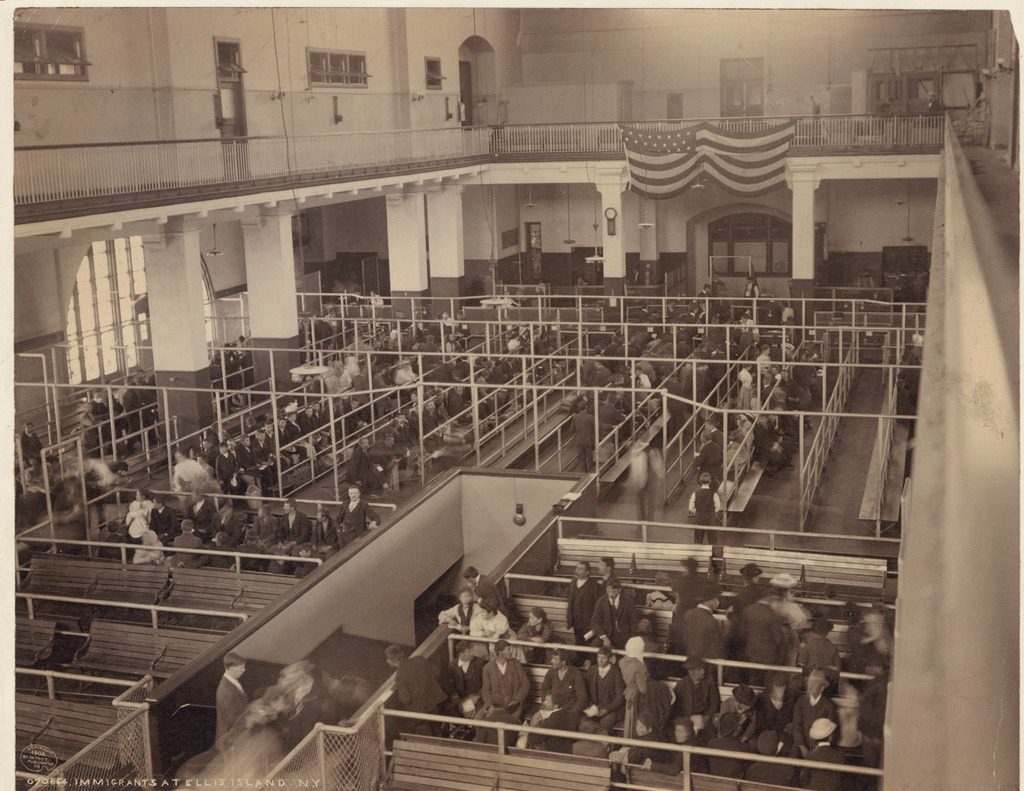
Second stop: Registry room
From the baggage room, immigrants would climb up the stairs to enter the registry room. On most days, there could be as many as 5,000-6,000 immigrants waiting to be processed.
One immigrant described the scene as a Tower of Babel — masses of people huddled together, all speaking different languages and all full of fear.
Fear of the unknown. Fear of being sent to the hospital. Fear of deportation. Fear of being separated from their family. Can you imagine the endless possibilities running through their minds?
The next step was a physical and then an interview.
Immigrants were stringently interrogated by the immigration officers. They’d be asked why they were coming, where they were planning to live, how they were planning to support themselves and even about their political beliefs.
Only two steps, but it required hours and hours of waiting.
The physical

From the moment they stepped foot onto Ellis Island, immigrants were watched carefully. As you climbed the steps to the registry room, doctors would look for heart problems, difficulty breathing, any kind of disability.
When it was time for the physical exam, doctors had less than 30 seconds to decide whether an immigrant needed further examination. Those who weren’t fit enough to become laborers, or were considered too weak, sick, or mentally unstable, would be chalked and possibly sent home.
“Chalking” meant the doctor would take white piece of chalk and mark their clothing, indicating a special condition. The mark would correspond to one of hundreds of diseases or ailments that the doctor might suspect.
Being chalked was one of the immigrants’ worst fears. It meant that, instead of continuing into the country, you would be sent to the hospital for further testing.
Firsthand accounts from the physical
As you might expect, firsthand accounts of the physical aren’t very positive.
- They would tell each other “beware the buttonhook men.” The trachoma exam was unpleasant because a doctor used a buttonhook to turn the eyelids inside out and check for this contagious disease. But it wasn’t the discomfort that was worrying — anyone with the condition faced deportation or treatment, both frightening alternatives.
- For one young, immigrant child the worst memory of Ellis Island was the physical. Doctors would be seated at a long table, in front of a basin of potassium chloride. In front of everybody, he had to undergo a “short arm” inspection. This term is a euphemism referring to the inspections of male soldier’s private parts.
- Another young immigrant described being in a big open room as doctors came in telling everyone to strip. Her mother had never undressed in front of her own children but was forced to in order to pass inspection. watching a young woman with beautifully braided hair being clipped, the doctors cutting her hair every which way. When she started to cry, she was told that if she wanted to be in America, her hair had to be clean.
The Ellis Island hospital

Of the thousands of immigrants who came through Ellis Island every day, approximately 1 in 5 were marked with chalk. There were no exceptions made for children or families. If a 3-year-old was marked and their mother was not, the pair would be separated until the child was deemed healthy.
-
of the hospital remembers being placed in a wagon and pushed across a metal bridge. Away from New York and from the rest of her family. Her first thought was “how can I escape?” being only 5 years old when he was hospitalized at Ellis Island and taken away from his mother. Because he only spoke French, he couldn’t understand anything that was going on around him or anything being said to him.
Hospital staff, meanwhile, were overwhelmed: 10,000 patients from over 70 different countries filled the halls. Doctors and nurses worked long hours to meet the demand and administer treatments to the crowds of people.
Trachoma at Ellis Island
One of the most widespread diseases at the time was trachoma, an infectious eye disease that eventually led to blindness.
An Italian immigrant was almost deported when she was diagnosed. Luckily for her, her father was able to gather enough money for her medical treatment at the hospital, and after 11 months of treatment she was cured and set free. Not all immigrants could afford this same care.
Without the proper antibiotics, there wasn’t a clear solution to help the immigrants who were infected. Doctors would rub patients’ eyelids with blue stones, hoping to soothe the inflammation, but the process was uncomfortable and often ineffective.
Happy memories
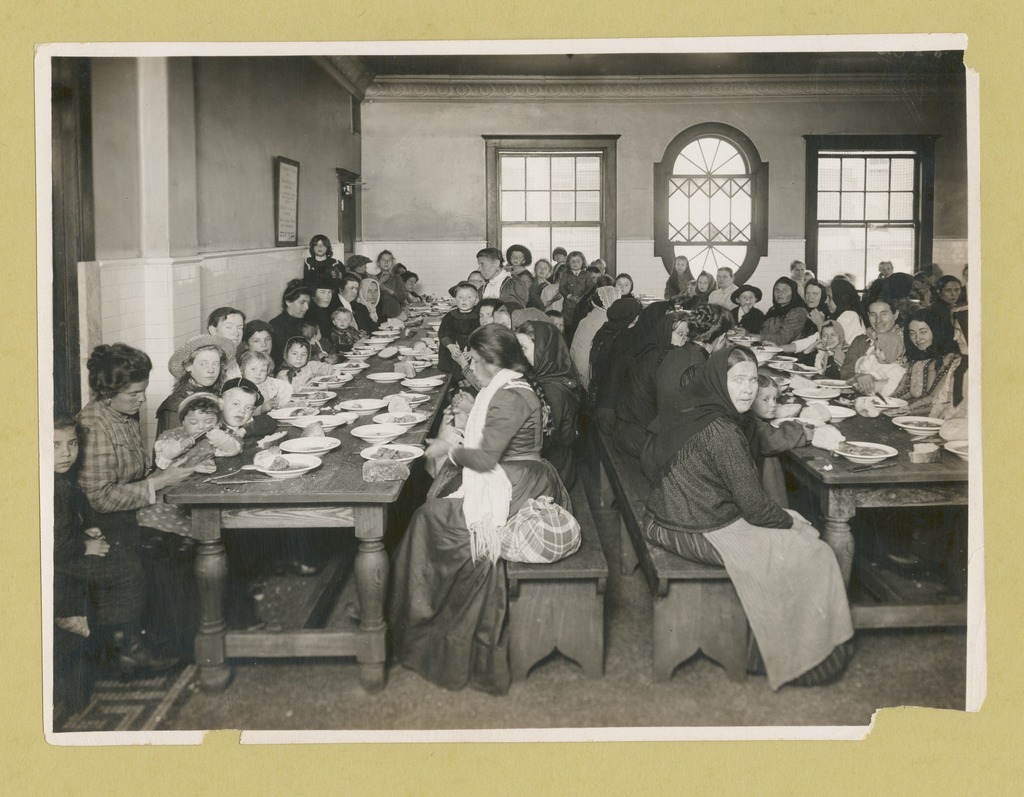
Not all the experiences at Ellis Island were scary. Many immigrants had positive memories of their stay in the hospital.
- Gifts from ladies in white:Some recall actually receiving gifts from the nurses, or “ladies in white,” as many people called them.
- Holiday festivities: During the Christmas season, the staff spent time distributing treats to children. Immigrant children remember thousands of toys, chocolate cakes and hundreds of sticks of candy.
Fear of the unknown
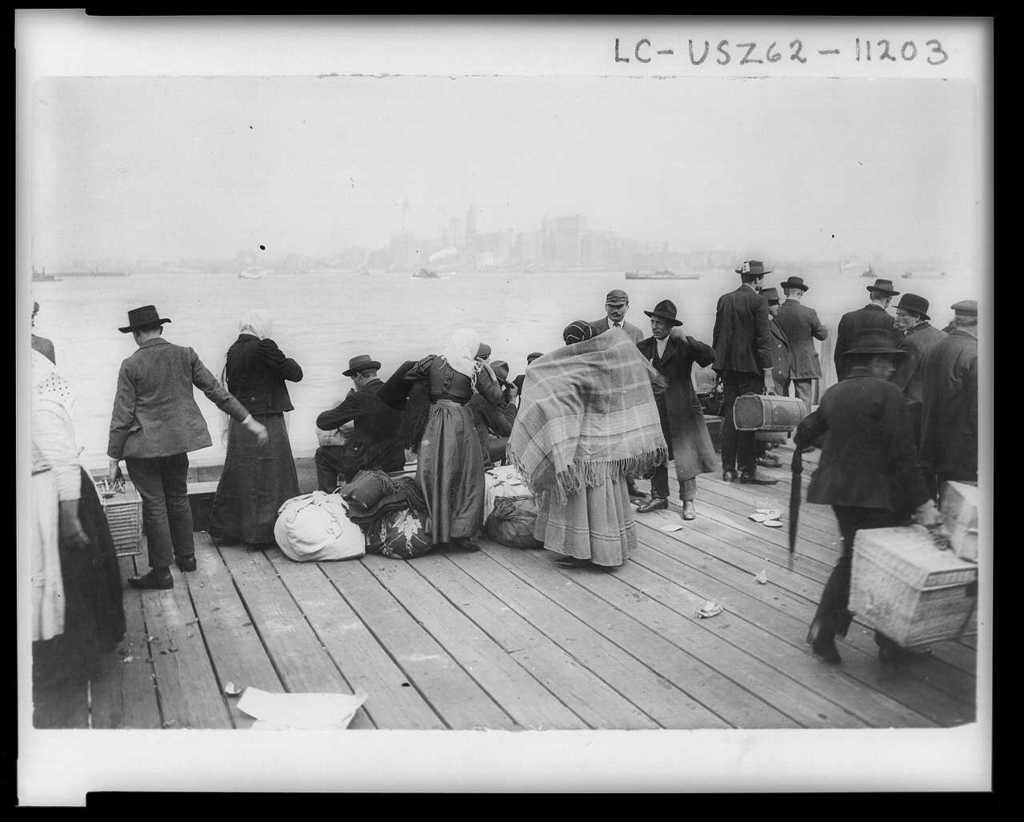
For the immigrants who wound up at the hospital and were worried, much of this stemmed from being surrounded by people they didn’t know in a situation they had never before experienced.
Many nurses recall immigrants being afraid to get into a bathtub. They had never seen this type of contraption before and feared they might drown if they got in.
One immigrant refused to get an X-ray. She thought it meant the police wanted her photo. Knowing she did nothing wrong, and not wanting to remove her clothes, she refused to have the test done.
But immigrants weren’t the only people dealing with the unknown. The doctors and nurses were tasked with curing diseases from all over the world, many of which did not have proper diagnosed treatment.
Mental exams and interviews at Ellis Island

Immigrants were stringently interrogated by the immigration officers. They’d be asked why they were coming, where they were planning to live, how they were planning to support themselves and even about their political beliefs.
Every immigrant who passed the health inspection then had to undergo a mental exam. The government was hoping to weed out anyone who they found to be “feeble minded” or mentally unfit. Many of the test results were based only on facial appearance.
-
her sister being denied and sent back home because an officer declared that she had weak eyes. being so nervous that when she was asked about the number of feet on a horse, she thought it was a trick question and answered two.
Language barriers
Unfortunately, many of the immigrants were considered to be uneducated, even stupid, if they didn’t speak proper English. The test only gave the government another excuse for deportation.
A Jewish mother and sister were lucky enough to escape Nazi Germany and catch a ship to America. But their deafness was seen as a burden by immigration officials, and they were detained at Ellis Island for months.
Island of Hope, Island of Tears
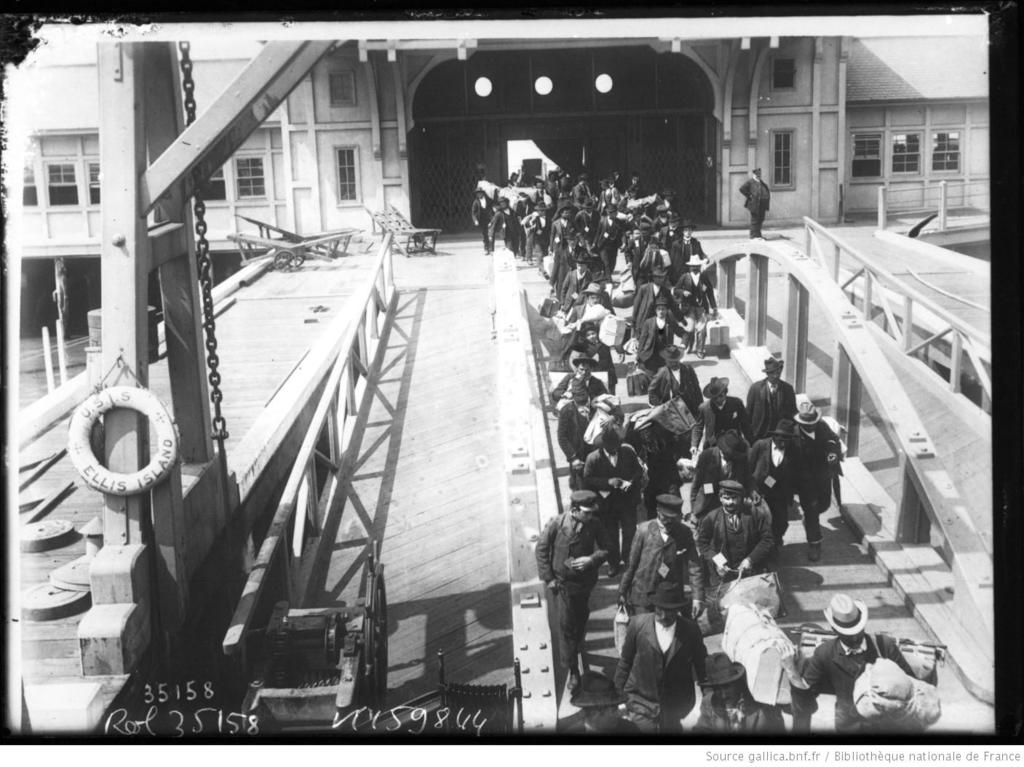
Reading these stories, you can see why Ellis Island was often referred to as the “Island of Hope, Island of Tears.” It’s amazing to think that a place that provided so many immigrants with promise and excitement could also be so terrifying and heartbreaking.
Being an immigrant wasn’t easy. The journey through Ellis Island was intimidating and often frightening. But despite their fears and doubts, millions of people made the trip and built a better future for themselves and their families.
The story of migration at Ellis Island

Have you ever heard of Ellis Island? Many know it as the gateway of immigration in the early 1900s, but you may not realize how easy it was to become an American at that time. In fact, most immigrants’ citizenship processes only took a few hours. Read onto to learn more about the fascinating history of Ellis Island.
A safe place to land
Established on January 1, 1892, Ellis Island was seen as a safe place to land for countless immigrants. Over 12 million newcomers came to Ellis Island from its founding until 1954. In the year 1907, 1,004,756 settlers came to America in a single year. People came to the United States for various reasons, but the most commons ones were to escape persecution and to take advantage of the economy. For almost all of the travelers, it only took a couple of hours to become an American citizen. According to associate history professor Vincent Cannato, “it varied from person to person, but for 80 percent, the process took a few hours, and then they were out and through,” he said. “But it could also take a couple days, a couple weeks, a couple months or, in some very rare cases, a couple of years,” he stated.
At that time, immigrants only had a hand-written passenger manifest document to denote their name, age, occupation, and destination. This piece of paper was basically all that they needed to confirm their identity. Doctors also needed a way to pre-screen newcomers for health issues. Before the migrant’s ship was allowed into the New York Harbor, it had to be quarantined near Staten Island. Health professional would check for infectious illness like smallpox, yellow fever, and cholera before it was allowed to deliver its passengers. Since there were 2,000 to 3,000 new arrivals per boat, the doctors had their work cut out for them.
City of immigrants
With most immigrants traveling from Italy, the language barrier was extremely thick. Thankfully, the doctor’s knew a few words of every language and had their own code for treating patients. According to historian Barry Moreno, “The doctors also had to know a few words of instruction in many languages. “Most of the immigrants were illiterate even in their own languages. And by 1907, the doctors had already developed a secret code system using a piece of chalk. They would mark the passenger’s clothes with a letter of the alphabet: ‘H’ indicated heart trouble suspected; ‘L’ suspected lameness; ‘X’ suspected feeble-mindedness, and so on,” he said.
If an immigrant didn’t pass the test, they were kept in the “doctor’s pen” to wait for more extensive care. This rare screening process only happened to 10 percent of the travelers. Since doctors’ knew that they couldn’t keep too many people in custody, they kept their numbers small. These passengers would then be interviewed again by officials, and if their answers weren’t up to par, they would be detained until further notice. While this process occurred by a case by case process, the immigrant actually had the option to appeal their detainment as long as they didn’t mind waiting a few more weeks.
Incomers who were lucky enough to avoid detainment were released as soon as possible. Not only that, but most were released within three to five hours. Although they weren’t allowed to sleep overnight or eat a meal, they did have the option to purchase their own food in the cafeteria. Moreno remarked that “If they wanted a meal, they could go downstairs to the lunchroom where the restaurant keeper sold boxed lunches: a large box for $1, a small box for 50 cents. In the box were a sandwich, pie and an apple. The only free food was given to detainees held forcibly overnight.”
This is America
Once settlers passed the Ellis Island inspection, they were allowed to enter the country but they weren’t given any documents to denote their new status as Americans. Cannato declared that “It’s a hard thing to wrap your mind around because we live in such a bureaucratic world today. We have passports, birth certificates and all sorts of documents. There was no, ‘Welcome to America, here’s your new photo ID.”
By the year 1924, Ellis Island was still operating in full swing. The haven for immigration also served multiple purposes. When World War II hit, it was used to house rival sailors in its baggage claim and its residence hall. It was also utilized by the U.S. Coast Guard to train approximately 60,000 military men. At the end of 1954, the final refugee was released and the immigration gateway closed its prestigious doors.
President Lyndon B. Johnson appointed Ellis Island as a branch of the Statue of Liberty National Monument in 1965. It was actually open to the public for the first time from 1974 to 1984. By that time, it was time for the migrant portal to undergo a major facelift. Its renovation was literally the biggest historic remodeling in American history. It took $160 million to complete the project, which was paid for by donations to The Statue of Liberty – Ellis Island Foundation, Inc. in collaboration with the National Park Service.
On September 10, 1990, its main building was reintroduced to the general public and was renamed the Ellis Island Immigration Museum. By May 20, 2015, the construction of the Peopling of America Center was complete and the museum’s name was changed to Ellis Island National Museum of Immigration. Now, two million visitors make the pilgrimage to the museum every year to learn about America’s rich history.
Source https://www.grunge.com/184860/the-bizarre-history-of-ellis-island/
Source https://www.statueoflibertytour.com/blog/what-life-was-like-for-an-ellis-island-immigrant/
Source https://www.history101.com/story-migration-ellis-island